Tactile Valentine’s Gingerbread House Craft
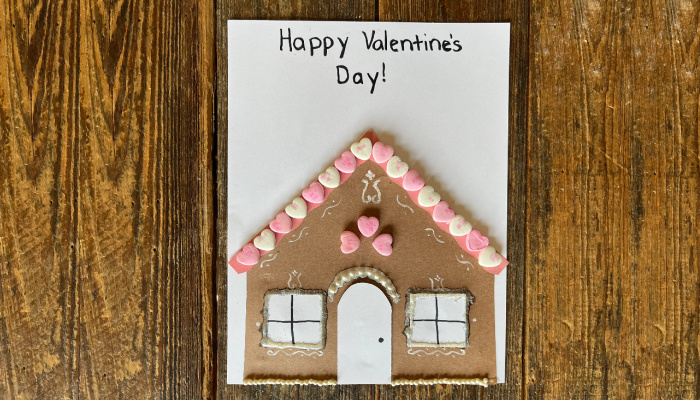
This post may contain affiliate links; please see our terms of use for details.
One of my favorite activities around the holidays is making gingerbread houses. The colorful decorations on miniature houses are fun for both kids and adults. But what happens when the holidays are over?
Thanks to new trends in Valentine’s Day decor, many parents are creating their own Valentine’s Day Gingerbread Houses. I love how beautiful these pastel-colored houses turn out. The pink accents amid white swirls are delightful.
My daughters and I were determined to make our own Valentine’s houses this year to decorate for Valentine’s Day, so we set out to find the perfect materials to use. Using just cardstock paper and some candy decor, we made this deliciously cute house.
You can make your own Valentine’s Gingerbread House Craft too using items you have around the house. Some basic craft supplies are all you need.
Valentine’s Gingerbread House: What You’ll Need
There are endless ways to decorate this house. Feel free to use my list of supplies as a suggestion. This craft will work with a variety of paper, glue, and decorations.

Materials:
- Cardstock paper or construction paper
- Paint
- Glue
- Scissors
- Decorations (Ribbons, sprinkles, beads, etc)
- Markers
Setup:
To get the house ready for decorations, you might want to make a few pieces ahead of time by following these steps:
Cut Roof
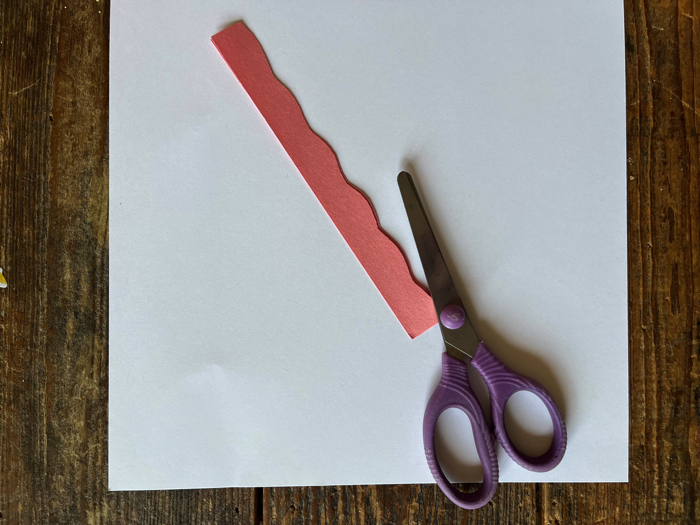
I used two strips of pink construction paper to create the roof line. You can easily cut a scalloped edge on the roof with scissors to create a cottage look. The length of the roof strips will determine how wide your house is.
Cut House

Using the roof strips as a guide, cut a house out of brown construction paper. You’ll want to make sure the house is large enough to fit the decorations you’ll be using.
Cut Windows and Door

Cut out the windows and a door from white construction paper. Make any shape you’d like, including circles, arches, rectangles, or squares.
Time to Craft
When it’s time to create your Valentine’s Gingerbread House, the steps are simple.
Step 1: Lay out all the pieces for your child to assemble the house. Show them how to lay the roof over the top of the house and where to put the windows and door.
Step 2: Let your child glue down all the pieces. (We found Elmer’s glue works great, but a glue stick would also work.)
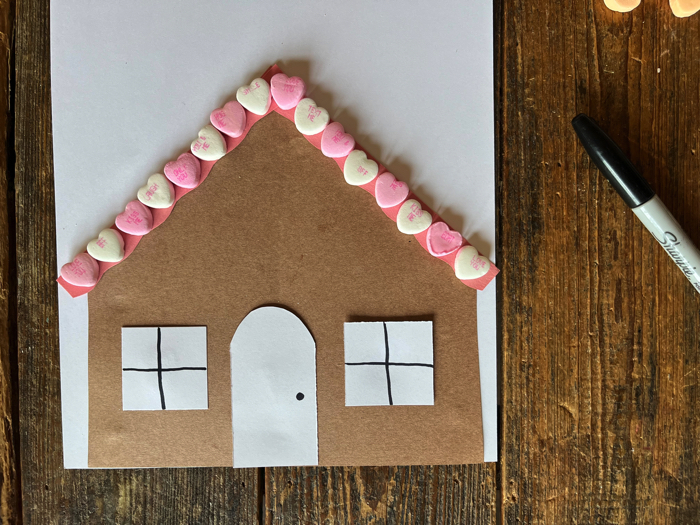
Step 3: Using paint and a small brush or a paint pen, let your child add “icing” details to the house. White paint will show up best against the brown house.
Step 4: Provide your child with a variety of decorations to embellish the house with. Elmer’s glue will work well to secure candies and bulky items on the paper. Smaller children might need help placing the glue.

What else can I use to decorate this Valentine’s house?
The best thing about this “gingerbread house” is that the decorations don’t all have to be edible. You can mix both candy and craft supplies to create an adorable design. Here are a few ideas to get you going:
- Conversation hearts
- Pink, red, or white ribbon
- Glitter
- Pink, red, or white sequins
- Valentine’s M&M’s
- Brach’s Candy Hearts
- Valentine’s Nerds
- Twizzlers
How to Display the Valentine’s Gingerbread House Craft

A tiny house covered in candy, glitter, and ribbons is the perfect decoration for Valentine’s Day. This house is too cute to leave lying around. Here are two ways you can utilize this craft to bring joy.
Interchangeable Art Frames
- 【High Capacity】Perfectly suited for 8.5×11 inch or smaller artwork, our frame has a depth of 0.6 inches, making it capable of holding 50-150 pieces of children’s artwork depending on paper thickness. Store and showcase your child’s artwork all in one place.
- 【Special Design】Elevate your art display game with our 180º open-front design kids art frames. This design allows for easy and convenient opening and closing, and features elastic bands that allow you to showcase your artwork or store old ones. Get the best of both worlds – showcase and store your child’s artistic masterpieces in the best way possible.
- 【Excellent Quality】Our kids art frames is made with high-quality, eco-friendly materials and features crystal-clear glass that offers a stunning and clear visual display of your child’s artwork. Our frame adds a touch of elegance and artistic atmosphere to any room, enhancing the beauty of your child’s creations.
- 【Easy of Use】Our art display frame is designed with a magnetic closure system, making it easy to change out photos or artwork. In addition, there are two sets (four) hooks on the back of the frame that allow for horizontal or vertical hanging to best display your child’s artwork.
Interchangeable art frames allow you to switch out your child’s artwork as often as you’d like. Most of these frames open like a door, allowing you to add or remove artwork instantly. These frames will allow you to display seasonal artwork, such as a watercolor popsicle painting in summer or a snowy scene finger painting in the winter.
Valentine’s Day Card
Your child might have a loved one they want to share this craft with. If so, consider turning it into a Valentine’s Day card.
To do this, just reduce the size of the house to half the size of a piece of cardstock paper. Fold the cardstock in half, glue the house on the outside, and write a message inside the paper. Who wouldn’t want a Valentine’s card this sweet?
What skills does this craft help develop?
Many crafts and activities support your child’s skill development without them knowing. Play can also be therapy! Here are a few ways this activity supports your child’s development.
Fine Motor Skills
Picking up conversation hearts and tiny beads takes a lot of practice and hard work. For a child to pinch and pick up objects, they need adequate fine motor skills.
Both fine and gross motor skills are needed for healthy development, but fine motor skills are the ones responsible for pinching, grabbing, folding, cutting, etc. Letting your child decorate a gingerbread house will provide plenty of practice.
Creative Skills
Creativity is what expands a child’s brain to think of new possibilities. Creative thinking will serve your child well in school and the workplace. Children who learn to think outside the box often become great problem solvers as well.
Color Recognition
You can easily use this craft to reinforce color recognition simply through conversation. As you select decorations for the house, talk about the colors. Reinforce the color names by saying things like, “Oh, I see you chose a blue heart to decorate with. What a beautiful blue heart that is!”
Playing other games, like our mushroom color sorting activity, will help reinforce color names as well.
Pattern Making
The roof of this house provides a great space for pattern making. Using beads or conversation hearts, you can help your child create patterns. To help your child grasp the concept of pattern making, start a pattern and have them finish it.
What other ways can I enrich this activity?
Don’t stop here! Try one of these fun Valentine’s Day themed activities to make this craft more memorable:
- Pun-filled book about the love between parent and child
- Encourages family bonding, laughter
- Charming, heart-melting illustrations on each page
- Words by Rose Rossner
- Try one of our top 10 sensory Valentine’s activities
- Read the book I Love You Like No Otter by Rose Rossner
- Make homemade Valentine’s cards
- Make Valentine’s Day sugar cookies with candy decorations
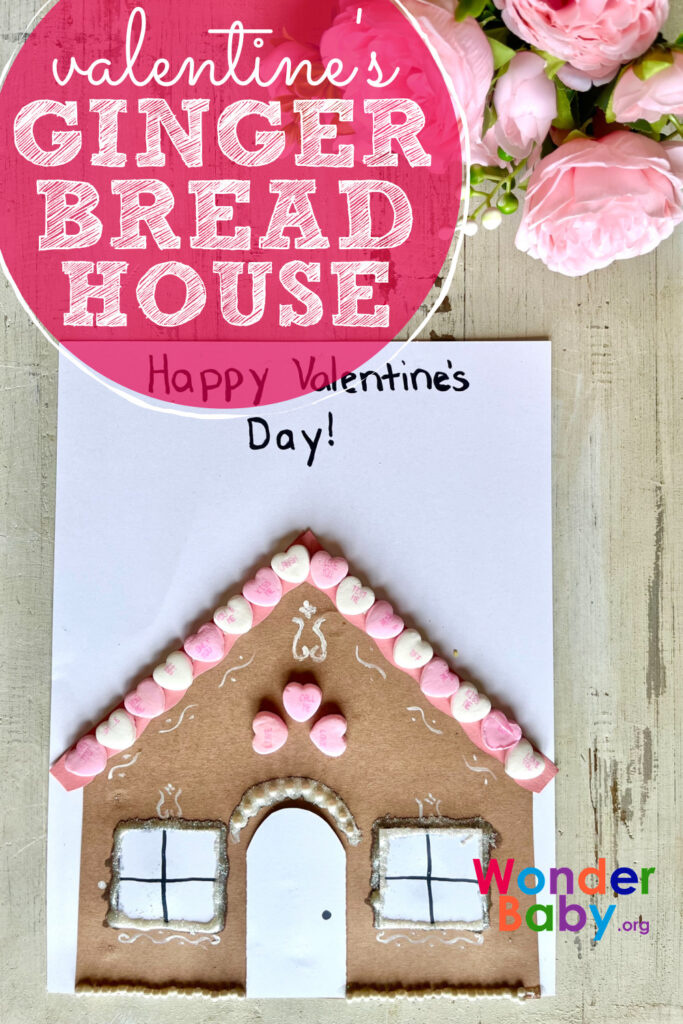
Related Posts

Holiday Crafts and Ideas
Should Parents Lie to Their Kids About Santa Claus?
Should parents lie about Santa? Find out how to balance trust, magic, and holiday traditions right here!
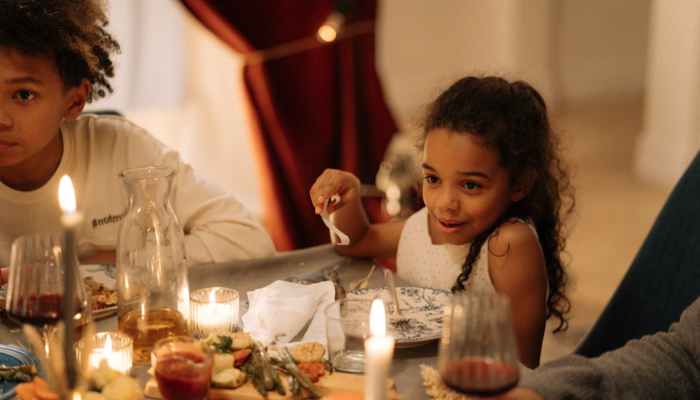
Holiday Crafts and Ideas, Special Needs
5 Tips for a Peaceful Thanksgiving with Your Child with Disabilities
Thanksgiving can be a joyful yet overwhelming holiday, especially for families with children who have sensory, motor, or dietary needs.

Tactile Arts and Crafts, Visual Impairment
Using Origami to Teach Blind and Low-Vision Students Basic Shapes
If, like me, you have wondered why it is important for young students to learn about shapes, here are just a few reasons. Teaching shapes in early education provides children...

